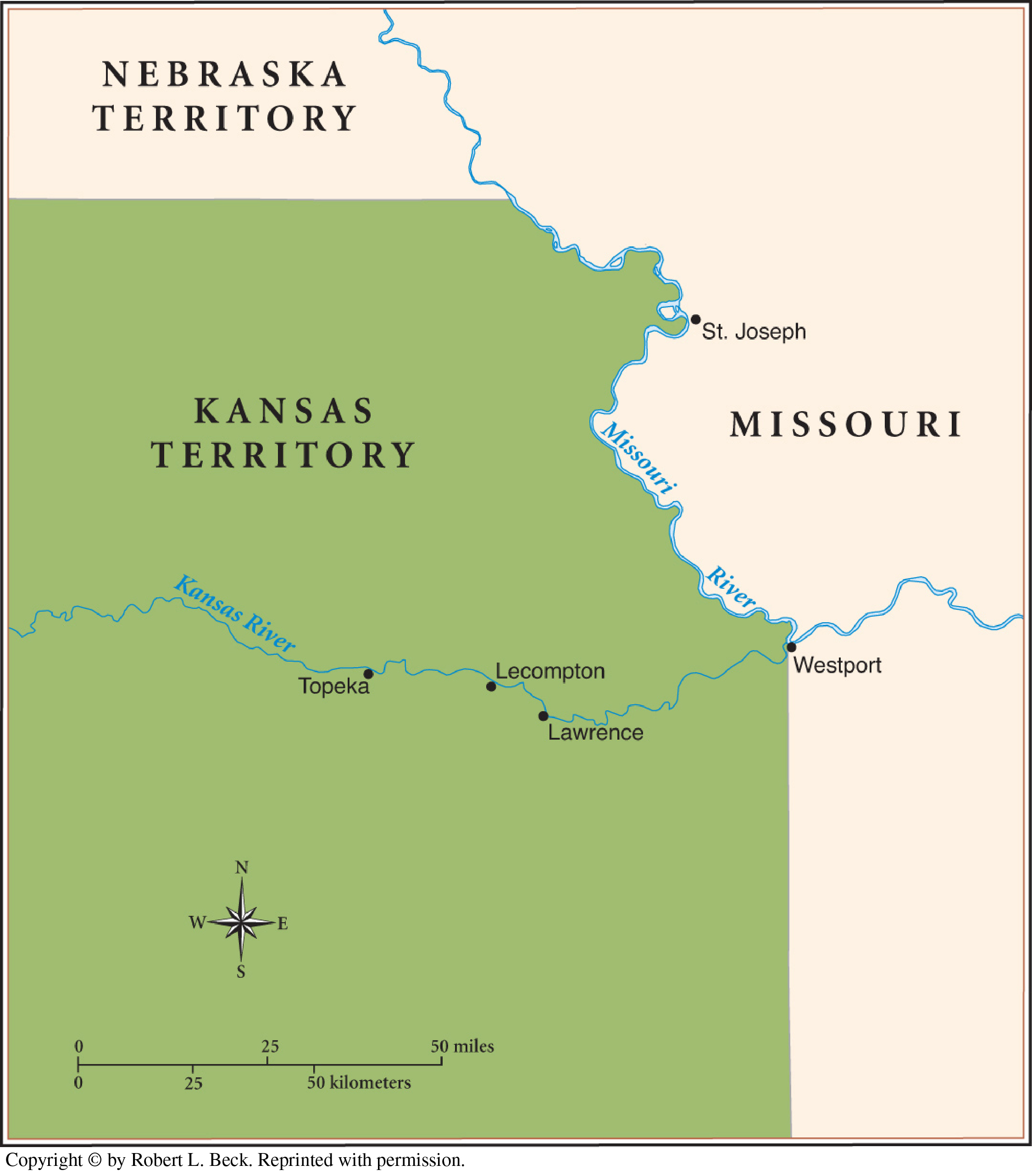Historical Background
Timeline
| January 1854 | Stephen A. Douglas introduces the Kansas-Nebraska Act. |
| May 1854 | Congress passes the Kansas-Nebraska Act. |
| Summer 1854 | Republican Party organized. |
| July 1854 | New England Emigrant Aid Company is organized. |
| February 1855 | Census taken in Kansas Territory. |
| March 1855 | Election of a territorial legislature. |
| August–October 1855 | Territorial legislature meets and passes a Slave Code for Kansas. |
| November 1855 | Free-state government formed at Topeka. Proslavery “law and order” movement formed. |
| November–December 1855 | Wakarusa War. |
| January 1856 | President Franklin Pierce proclaims the free-state movement to be treasonous. |
| May 1856 | Proslavery mob “sacks” Lawrence, Kansas. |
| John Brown’s party kills five proslavery settlers near Pottawatomie Creek in southeastern Kansas. | |
| May–September 1856 | Summer of Bleeding Kansas. |
| September 1856 | John Geary becomes new governor of Kansas Territory. |
| 1857–1858 | Controversy over proslavery Lecompton Constitution. |
| 1858 | Abraham Lincoln challenges Stephen A. Douglas for the U.S. Senate seat in Illinois. |
| October 1859 | John Brown’s party raids Harpers Ferry, Virginia. |
| November 1860 | Abraham Lincoln elected president. |
| December 1860 | South Carolina secedes from the Union. |
The Missouri Compromise of 1820 forbade slavery in what became Kansas Territory. By 1854, when western settlers were ready to move into that region, Senator Stephen A. Douglas of Illinois introduced a bill to organize the territory. Southern congressmen had no interest in creating free territories, so Douglas’s Kansas-Nebraska Act removed the prohibition on slavery. Instead, the territories were organized under the principle of popular sovereignty, the right of the settlers to determine whether to have slavery. While southerners embraced the legislation, many northerners were outraged.
Missourians expected to dominate Kansas. But antislavery New Englanders organized a small migration, and many more settlers came from the Midwest. These midwesterners were less likely than the New Englanders to oppose slavery, but they allied with the New Englanders to make Kansas a free state when proslavery men won the first territorial elections by fraud. Midwestern and New England settlers formed a political movement called the Free-State Party, which had no legal authority but was probably supported by the majority of settlers. Free-staters refused to cooperate with the proslavery territorial government.
This situation was bound to cause conflict. In May 1856, a proslavery mob rampaged through Lawrence, Kansas, a New England settlement. This event, called the “Sack of Lawrence,” demonstrated to northerners the disorder in the territory. In southeastern Kansas, near Pottawatomie Creek, settler John Brown was on his way to defend Lawrence. When he heard of the attack, Brown and others killed five proslavery men. Guerrilla bands, proslavery and free-state, now roamed the territory, burning out settlers and fighting small skirmishes.
Finally, a new territorial governor, John Geary, succeeded in restoring order. He ordered the army to disband unless it agreed to arrest any armed parties in the territory. Even after Geary quelled the fighting, however, the repercussions of Bleeding Kansas affected the nation. Public reaction to the Kansas-Nebraska Act led to the creation of the Republican Party and brought Abraham Lincoln out of political retirement. Controversy over Kansas Territory continued when proslavery settlers attempted to force a proslavery state constitution on the unwilling free-staters. This constitution failed to pass in Congress, but it kept the sectional crisis over slavery in the territories alive. Then John Brown and a small band of men attacked the federal arsenal in Harpers Ferry, Virginia, hoping to start a slave rebellion. Although Brown was captured and executed, he was widely admired in the North, horrifying white southerners and convincing them they could no longer trust northerners. When Abraham Lincoln became the first Republican elected president, Lower South states began to secede from the Union. Lincoln had, after all, publicly agreed with John Brown that slavery was wrong, even if he had condemned Brown’s use of violence. Ironically, Lincoln would preside over the bloodiest episode of U.S. history: the Civil War, which finally ended American slavery.
Kansas Territory
